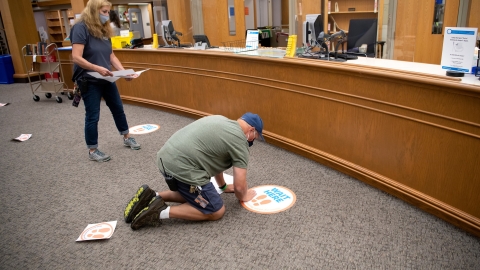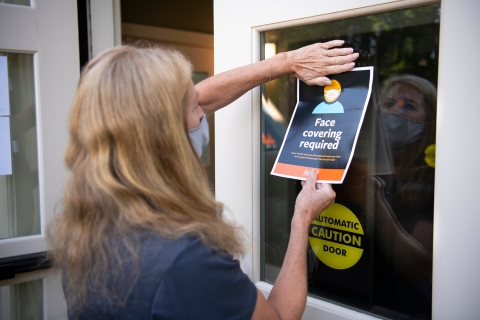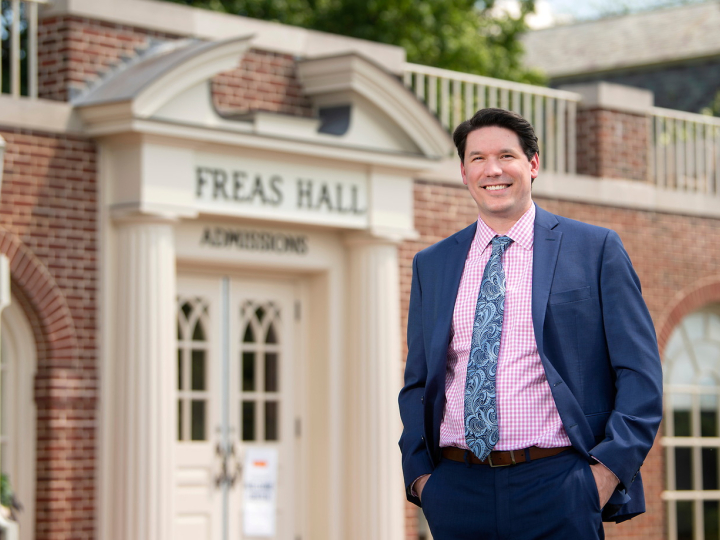
Bucknell Releases Comprehensive Fall Reopening Plan
July 21, 2020
Members of the Facilities staff place signage in Bertrand Library to reinforce social distancing measures. Photo by Emily Paine, Communications
When students return to Bucknell in August, they'll find a campus that will look and feel much different from the one they left in March when the COVID-19 pandemic sent them home.
Teams of University personnel have been working for months on a fall plan that puts health and safety measures in place to reopen campus as safely as possible while still providing Bucknell's traditional robust residential experience. But execution of that plan will require everyone to become active participants.
"Our ability to enjoy as rich of an in-person, residential experience as we can in the midst of the COVID-19 pandemic is going to depend on all of us," President John Bravman wrote in an email to students and families. "This is all about community, about caring for one another, and recognizing that shared sacrifice will be implicit in our success."
Keeping COVID Off Campus
The best way to keep COVID-19 off campus is to make sure that it doesn't enter in the first place. That's why the University will provide a comprehensive testing protocol for students, faculty and staff that includes pre-arrival testing, screening by Student Health personnel, and contact tracing processes and procedures.
Bucknell has contracted with GENETWORx to deliver two COVID test kits to each student — the first a saliva test and the second a midnasal swab test. When students arrive on campus to check in, they will be required to show the medical staff their two negative tests through their Bucknell app. There is no charge to students for these tests or shipping.
Students who don't already have a recent negative test for the virus will be tested upon arrival and isolated until they test negative. Students who test positive during the semester will be quarantined for two weeks at a local hotel, or given the option to return home.
After the Student Health screening, students will be required to sign electronically a new Community Responsibility Agreement. It requires them to support the health and safety of all members of the campus community and engage in behavioral public safety measures intended to mitigate the spread of the virus — specifically physical distancing, wearing face coverings, respiratory etiquette, proper hand hygiene, reporting of symptoms and isolation. Upon signing, students will be given a wellness kit containing two Bucknell face coverings, hand sanitizer and a thermometer.
"We plan to test students prior to arrival to know their status is negative coming onto campus. If we can aggressively test and mitigate the spread once they're here, we're going to manage this virus tremendously," says Catherine O'Neil, M.D., medical director of Bucknell Student Health. "It takes practice to develop good health habits that can mitigate the spread of any disease. If we do it right, we have the ability to educate some 3,500 individuals to become socially responsible adults."
Around 300 students chose to take classes remotely from home, but Dean of Students Amy Badal looks forward to welcoming the rest back to a campus environment that may keep them safer than the outside world.
"We're excited about welcoming our students back to campus, and we're doing everything possible to mitigate the risk to them," Badal says. "The whole campus experience will look substantially different, but we are committed to providing the residential experience Bucknellians have grown to love."
Preparing Campus for the New Normal

More than 10,000 signs hung around campus reminded community members to adhere to health and safety protocols. Photo by Emily Paine, Communications
Students will only be permitted to live in single or double occupancy rooms now, and no visitors will be allowed in residence halls this fall. Students will notice additional signage to provide social distancing directional flow through some buildings and reinforcement of behavioral public safety measures.
University custodial and Facilities staff will provide increased cleaning and disinfection using Environmental Protection Agency-approved products that are effective against COVID-19. That will include twice-daily disinfecting of high-touch areas, and daily cleaning in the residence halls. Additional wall-mounted and free-standing hand sanitizing stations have been installed across campus, particularly at building entrances and in all classrooms and labs. Air hand dryers have been deactivated and replaced by paper dispensers in restrooms.
Classrooms will be disinfected daily during routine cleaning, but cleaning supplies will also be provided in classrooms, labs and conference rooms so occupants can clean desks and high-touch areas after use. Additionally, the Facilities team has maximized air filtration inside classrooms, providing access to outside air wherever possible.
Dining Services has transitioned to safer dining operations which include no buffet lines, take-out meals and limited seating occupancy in dining venues. Thirty octagonal dining tables will also provide additional outdoor seating.
Plexiglass shielding or barriers have been installed in some indoor spaces where there's a higher rate of face-to-face interaction, including at Bursar Services, Card Services and Student Mail Services.
The ‘New’ Pandemic-fitted Classroom
Many classrooms now have cameras and microphones to allow faculty to capture their lectures and discussions and post them online, providing students greater flexibility of access.
Most classrooms have had their capacity reduced by 50 percent to provide maximum social distancing. Some larger spaces that hadn't typically been used for classrooms — including Trout Auditorium, Gardner Lecture Hall, the Weis Center for the Performing Arts and Larison dining room — may now accommodate larger classes of up to 35 students. Additional outdoor locations are also being explored.
According to Robert Midkiff, vice president for strategic initiatives, who has been coordinating with the faculty to mitigate their risk of infection, more than 100 faculty members will be teaching one or more sections remotely this fall. An additional 16 will teach using a "blended modality" of both in-person and remote instruction. Of the 822 courses with 1,564 sections being offered in the fall, approximately 15% will be offered remotely, with 2% being "blended."
"The faculty are working hard to provide the quality of experience they've always provided, despite different modalities they're using in order to teach," says Midkiff. "I don't doubt any faculty member's commitment to providing the best educational opportunity they can. And some have discovered that they may be making permanent changes to their courses based on their experiences from the spring and now."
Midkiff wants students and families to know that while their Bucknell educational experience may look and feel different, the fulfillment of the University's primary educational mission will be accomplished through slightly different means.

